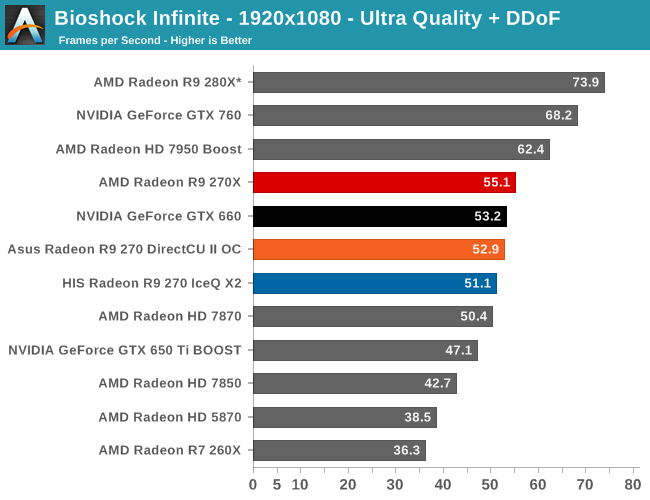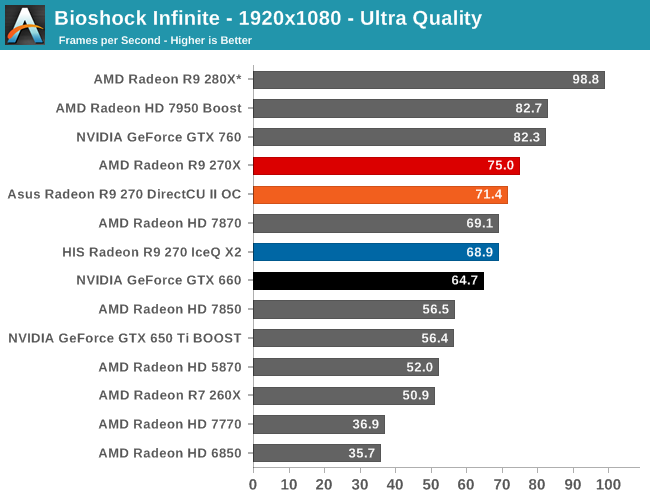The AMD Radeon R9 270X & R9 270 Review: Feat. Asus & HIS
by Ryan Smith on November 13, 2013 12:01 AM ESTBioshock Infinite
Bioshock Infinite is Irrational Games’ latest entry in the Bioshock franchise. Though it’s based on Unreal Engine 3 – making it our obligatory UE3 game – Irrational had added a number of effects that make the game rather GPU-intensive on its highest settings. As an added bonus it includes a built-in benchmark composed of several scenes, a rarity for UE3 engine games, so we can easily get a good representation of what Bioshock’s performance is like.


Bioshock tends to be a close matchup between similar AMD and NVIDIA cards, and this review is no exception. The 270X holds a small but distinct lead over the GTX 660, but the 270 vanilla trails the GeForce card by roughly the same amount. With the 270 and GTX 660 priced equivalently, this is essentially a slight loss for the 270.
On a side note, taking a moment to stop and look at the 270 in the frame of reference as a 150W card, we can see just how much AMD has improved their performance within the 150W envelope. Compared to their outgoing 7850, their last 150W card, the 270 is 20% faster. As we’ll see in a bit, real world power usage will be higher – there isn’t a free lunch on the same node – but for systems constrained by a 150W limit this is a clear improvement over previous options.










59 Comments
View All Comments
Will Robinson - Wednesday, November 13, 2013 - link
What!...no hatchet job on these new cards from Wreckage?The hurt just keeps on coming eh Wrecky?
just4U - Thursday, November 14, 2013 - link
It's not beating the 760 so his stocks are safe... for now. Besides, you need to give him a break. Poor man must be tired after the release of the 780Ti and 290/X.geniekid - Wednesday, November 13, 2013 - link
Would really have liked to see CFX numbers.Da W - Wednesday, November 13, 2013 - link
Agreed, i need to compare 270X crossfire performance/heat/noise to a single 290X.Right now i'm hesitating, for my 3 monitor setup:
1. Dual 270X for 400$. -Advantage of lower cost, lower heat, lower noise, turn off one GPU when not gaming. Don't know if it's strong enough for 3600X1920.
2. Single 290 for 450$. -Best price/performance, noisy, hot.
3. Single GTX 780 superclocked for 530$. - If only for Nvidia cooler and energy efficiency, else i'm an AMD guy.
4. Single 290X for 550$. -I would pick this over vanilla 290 for chip binning, it should have higher quality GPU as far as energy concumption goes.
Titan and 780ti are above my budget.
garadante - Wednesday, November 13, 2013 - link
I'm strongly doubting two of these would game at 3600x1920 comfortable. That's almost 4k resolution. Remember that any AMD card below the 290 series still uses the Crossfire bridge and can't transfer 4k resolution frame buffers through it. Making the second card completely useless as the buffer is just dropped instead. And I haven't seen technical info yet, but I wonder if that's part of the reason why the 290 series outperforms the 780/780 Ti in 4k gaming so well. Perhaps the SLI bridge is also becoming a bottleneck, depending on how it handles frame buffers.For that resolution, personally I'd say waiting for aftermarket 290s and 290Xs would be a good choice. Get either much better binned chips in a high end aftermarket 290 or 290X, better thermals, and acoustics for both (and thus better overclocking headroom). With the performance those cards were getting at 4K gaming, they could probably handle single card 3600x1920 at decent settings, though probably not highest without dropping significantly below 60 FPS. But it leaves room for adding a 2nd card, whereas starting with 270X doesn't. Looks like it only has 1 Crossfire bridge which means you can't add a third card.
Da W - Wednesday, November 13, 2013 - link
Good advice. I'll discard option number 1 then, and yes i'm waiting until we see custom coolers on the 290 series before i make a move, probably an MSI one to match my MB. Although that Nvidia cooler is cool looking as hell.....At "3.5K", i find that disabling AA or adjusting just a step below "ultra freaking high details" makes all games playable. By playable i mean above 30FPS.
krumme - Wednesday, November 13, 2013 - link
Where is the noise equalization test?It looks like the asus card is around 853% faster than the nearest competitor.
Streetwind - Wednesday, November 13, 2013 - link
Ryan, will you be adding the results from the various R7/R9 models tested in the last month or two to Bench eventually? The entire new series is absent so far, as is the GTX 780 Ti. I often use Bench for comparing my current card to potential upgrades, so it would be great to have.Ryan Smith - Wednesday, November 13, 2013 - link
Yes. GPU14 Bench will be up next week; I need to clean up the DB a bit first.yacoub35 - Wednesday, November 13, 2013 - link
So how come no mention of the 7950 in the conclusion? It's clearly the right choice, as you get 3GB of VRAM in addition to superior performance, and all for a price well under $200.